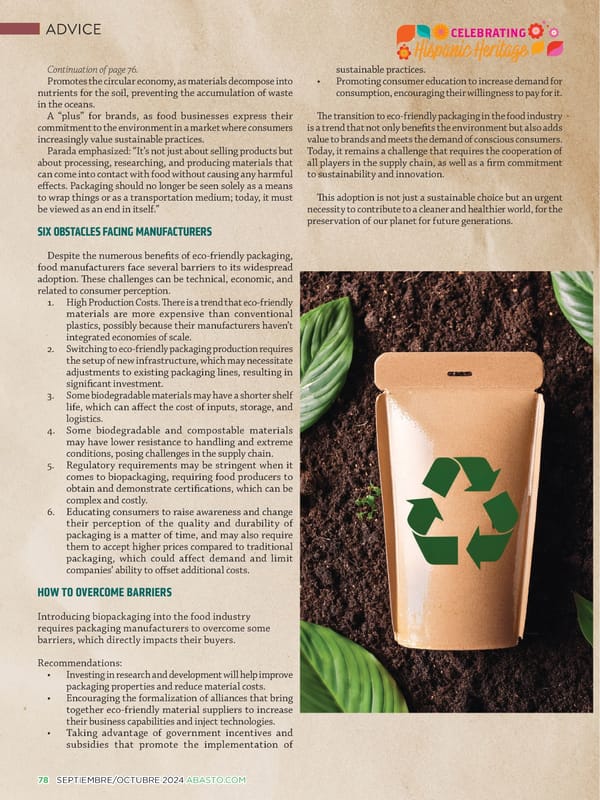Empaques ecológicos, Abasto Magazine
Los empaques ecológicos benefician la imagen de las marcas frente a los consumidores conscientes que buscan apoyar la construcción de un mundo más limpio.
ADVICE CELEBRATING Hispanic Heritage Continuation of page 76. sustainable practices. Promotes the circular economy, as materials decompose into • Promoting consumer education to increase demand for nutrients for the soil, preventing the accumulation of waste consumption, encouraging their willingness to pay for it. in the oceans. A “plus” for brands, as food businesses express their 吀栀e transition to eco-friendly packaging in the food industry commitment to the environment in a market where consumers is a trend that not only bene昀椀ts the environment but also adds increasingly value sustainable practices. value to brands and meets the demand of conscious consumers. Parada emphasized: “It’s not just about selling products but Today, it remains a challenge that requires the cooperation of about processing, researching, and producing materials that all players in the supply chain, as well as a 昀椀rm commitment can come into contact with food without causing any harmful to sustainability and innovation. e昀昀ects. Packaging should no longer be seen solely as a means to wrap things or as a transportation medium; today, it must 吀栀is adoption is not just a sustainable choice but an urgent be viewed as an end in itself.” necessity to contribute to a cleaner and healthier world, for the SIX OBSTACLES FACING MANUFACTURERS preservation of our planet for future generations. Despite the numerous bene昀椀ts of eco-friendly packaging, food manufacturers face several barriers to its widespread adoption. 吀栀ese challenges can be technical, economic, and related to consumer perception. 1. High Production Costs. 吀栀ere is a trend that eco-friendly materials are more expensive than conventional plastics, possibly because their manufacturers haven’t integrated economies of scale. 2. Switching to eco-friendly packaging production requires the setup of new infrastructure, which may necessitate adjustments to existing packaging lines, resulting in signi昀椀cant investment. 3. Some biodegradable materials may have a shorter shelf life, which can a昀昀ect the cost of inputs, storage, and logistics. 4. Some biodegradable and compostable materials may have lower resistance to handling and extreme conditions, posing challenges in the supply chain. 5. Regulatory requirements may be stringent when it comes to biopackaging, requiring food producers to obtain and demonstrate certi昀椀cations, which can be complex and costly. 6. Educating consumers to raise awareness and change their perception of the quality and durability of packaging is a matter of time, and may also require them to accept higher prices compared to traditional packaging, which could affect demand and limit companies’ ability to o昀昀set additional costs. HOW TO OVERCOME BARRIERS Introducing biopackaging into the food industry requires packaging manufacturers to overcome some barriers, which directly impacts their buyers. Recommendations: • Investing in research and development will help improve packaging properties and reduce material costs. • Encouraging the formalization of alliances that bring together eco-friendly material suppliers to increase their business capabilities and inject technologies. • Taking advantage of government incentives and subsidies that promote the implementation of 7878 SSEEPPTTIIEEMBRMBREE//OOCCTTUUBRBREE 2 2002244 AABBAASSTOTO..CCOOMM
 Abasto Magazine: September/October 2024 - ENGLISH Page 101 Page 103
Abasto Magazine: September/October 2024 - ENGLISH Page 101 Page 103